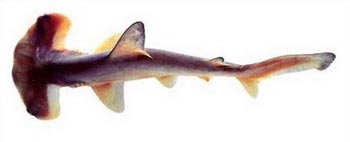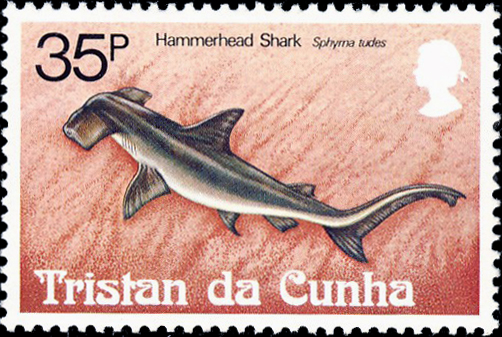Sphyrna tudes Valenciennes, 1822

Phylum: Chordata Haeckel, 1874
Subphylum: Vertebrata Lamarck J-B., 1801
Classe: Chondrichthyes Huxley, 1880
Ordine: Carcharhiniformes Compagno, 1977
Famiglia: Sphyrnidae Gill, 1872
Genere: Sphyrna Rafinesque, 1810
English: Smalleye hammerhead
Español: Cornuda tudes
Descrizione
misurano fino a 150 cm. I giovani si nutrono principalmente di Penaeidae (gamberi), in particolare di Xiphopenaeus kroyeri . Gli squali più grandi si nutrono di pesci ossei, in particolare Ariidae e le loro uova.
Diffusione
Si trova solo sulla costa orientale del Sud America , dall'Uruguay al Venezuela . La sua presenza nel Mediterraneo è stata segnalata da Valenciennes nel 1822, ma è probabilmente una confusione con Sphyrna couardi. Vive in acque costiere torbide, vicino al fondale marino, di solito tra 5 e 40 m di profondità. I maschi vivono a profondità maggiori rispetto alle femmine. I giovani vivono vicino alla superficie.
Sinonimi
= Sphyrna bigelowi Springer, 1944 = Zygaena tudes Valenciennes, 1822.
Bibliografia
–Pollom, R.; Barreto, R.; Charvet, P.; Chiaramonte, G.E.; Cuevas, J.M.; Faria, V.; Herman, K.; Lasso-Alcalá, O.; Marcante, F.; Mejía-Falla, P.A.; Montealegre-Quijano, S.; Motta, F.; Navia, A.F.; Nunes, J.; Paesch, L.; Rincon, G. (2020). "Sphyrna tudes". IUCN Red List of Threatened Species. 2020.
–Compagno, L.J.V. (1984). Sharks of the World: An Annotated and Illustrated Catalogue of Shark Species Known to Date. Food and Agricultural Organization of the United Nations. pp. 551-553.
–Castro, J.I. (1989). "The biology of the golden hammerhead, Sphyrna tudes, off Trinidad". Environmental Biology of Fishes. 24 (1): 3-11.
–Valenciennes, A. (1822). "Sur le sous-genre Marteau, Zygaena". Mémoires du Muséum National d'Histoire Naturelle. 9: 222-228.
–Springer, S. (1944). "Sphyrna bigelowi, a new hammerhead shark from off the Atlantic coast of South America, with notes on Sphyrna mokarran from New South Wales". Journal of the Washington Academy of Sciences. 34 (8): 274-276.
–Tortonese, E. (1950). "A note on the hammerhead shark, Sphyrna tudes Val. after a study of the types". Annals and Magazine of Natural History. 3 (36): 1030-1033.
–Gilbert, C.R. (1967). "A revision of the hammerhead sharks (family Sphyrnidae)". Proceedings of the United States National Museum. 119 (3539): 1-88.
–Cadenat, J. & Blache, J. (1981). Requins de Méditerranée et d'Atlantique. Editions de l'Office de la recherche scientifique et technique outre-mer. pp. 298-300.
–Lim, D.D.; Motta, P.; Mara, K.; Martin, A.P. (2010). "Phylogeny of hammerhead sharks (Family Sphyrnidae) inferred from mitochondrial and nuclear genes". Molecular Phylogenetics and Evolution. 55 (2): 572-579.
–Martin, R.A. (August 4, 1998). In Search of the Golden Hammerhead. ReefQuest Centre for Shark Research.
–Froese, Rainer; Pauly, Daniel (eds.) (2008). "Sphyrna tudes" in FishBase.
–Ferrari, A. & A. Ferrari (2002). Sharks. Firefly Books. p. 192.
–McEachran, J.D. & Fechhelm, J.D. (1998). Fishes of the Gulf of Mexico: Myxiniformes to Gasterosteiformes. University of Texas Press. p. 96.
–Gallagher, E. Biological Profiles: Smalleye Hammerhead. Florida Museum of Natural History Ichthyology Department.
–Lessa, R.; Menni, R.C. & Lucena, F. (September 1998). "Biological observations on Sphyrna lewini and S. tudes (Chondrichthyes, Sphyrnidae) from northern Brazil". Vie et Milieu. 48 (3): 203-213.
–Léopold, M. (2004). Poissons de mer de Guyane. Editions Quae. pp. 32-33.
–Belleville, B. (2004). Sunken Cities, Sacred Cenotes & Golden Sharks: Travels of a Water-Bound Adventurer. University of Georgia Press. pp. 168-176.
–Suriano, D.M. & Labriola, J.B. (January 1998). "Erpocotyle VanBeneden et Hesse, 1863 (Monogenea, Hexabothriidae), parasite of carcharhiniform fishes from the southwestern Atlantic Ocean, with the description of E. schmitti sp. n". Acta Parasitologica. 43 (1): 4-10.

|
Stato: Tristan da Cunha |
|---|